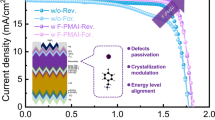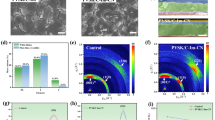Abstract
Correlations among the interface properties, optical absorption, thermal stability and power conversion efficiency (PCE) of organic photovoltaic (OPV) devices are a matter of investigation and need versatile approaches to get better understanding of such issues. In the present study, PCDTBT:PC71BM OPV devices were prepared on the ITO substrates, and the electron extracting electrodes were made of thin Al layers. The functionalization of these devices was done by interfacing the electron acceptor core–shell CdSe/ZnS nanostructures. The reduced electron–hole recombination processes, after interfacing the CdSe/ZnS nanostructures, have resulted in PL intensity quenching of the PCDTBT:PC71BM layer. FE-SEM and HR-TEM images confirm the growth of PC71BM particles as a function of annealing temperatures (100, 120 °C). At lower annealing temperature (100 °C), improved π–π stacking of PCDTBT:PC71BM layer could facilitated the significant charge production and transport which has resulted in higher Jsc values (~ 6.7 mA/cm2) as compared to those from the as-cast PCDTBT:PC71BM layer (4.3 mA/cm2). Interfacing of CdSe/ZnS nanostructures with the PCDTBT:PC71BM layer has resulted in a higher Jsc value (6.8 mA/cm2) which further enhanced to 8.9 mA/cm2, after the heat treatment at 100 °C. A burn-in process induced marginal deterioration in the Jsc and PCE values is also seen in the OPV devices after annealing at higher temperature (120 °C). Maximum PCE of 4.6% is achieved in the PCDTBT:PC71BM@CdSe/ZnS device, when compared with the PCE of PCDTBT:PC71BM basic device (3.2%), for the same operating temperature and annealing time, i.e. 100 °C for a 2 h.






Similar content being viewed by others

References
Barik P, Mandal AR, Kuznetsov D, Godymchuk A (2015) Synthesis and optical properties of CdSe and CdSe/ZnS core/shell quantum dots. Adv Mater Res 1085:176–181
Bertho S, Janssen G, Cleij TJ, Conings B, Moons W, Gadisa A, D’Haen J, Goovaerts E, Lutsen L, Manca J, Vanderzande D (2008) Effect of temperature on the morphological and photovoltaic stability of bulk heterojunction polymer: fullerene solar cells. Sol Energy Mater Sol Cells 92:753–760
Blouni N, Michaud A, Leclerc M (2007) A Low-Bandgap Poly(2,7-Carbazole) derivative for use in high-performance solar cells. Adv Mater 19(17):2295–2300
Chen R, Shen YQ, Xiao F, Liu B, Gurzadyan GG, Dong ZL, Sun XW, Sun HD (2010) Surface Eu-treated ZnO nanowires with efficient red emission. J Phys Chem C 114(42):18081–18084
Cheng Y, Hsieh C, Li P, Hsu C (2011) Morphological stabilization by in situ polymerization of fullerene derivatives leading to efficient, thermally stable organic photovoltaics. Adv Funct Mater 21(09):1723–1732
Cho S, Seo JH, Park SH, Beaupre S, Leclerc M, Heeger AJ (2010) A thermally stable semiconducting polymer. Adv Mater 22(11):1253–1257
Dang C, Lee J, Breen C, Steckel JS, Coe-Sullivan S, Nurmikko A (2012) Red, green and blue lasing enabled by single-exciton gain in colloidal quantum dot films. Nat Nanotechnol 7(5):335–339
Dixit SK, Madan S, Madhwal D, Kumar J, Singh I, Bhatia CS, Bhatnagar PK, Mathur PC (2012) Bulk heterojunction formation with induced concentration gradient from a bilayer structure of P3HT:CdSe/ZnS quantum dots using interdiffusion process for developing high efficiency solar cell. Org Electron 13:710–714
Ebadian S, Gholamkhass B, Shambayati S, Steven H, Peyman S (2010) Effects of annealing and degradation on regioregular polythiophene-based bulk heterojunction organic photovoltaic devices. Sol Energy Mater Sol Cells 94(12):2258–2264
Etzold F, Howard IA, Meister M, Kim T, Lee k, Baek NS, Laquai F, (2011) Ultrafast exciton dissociation followed by non geminate charge recombination in PCDTBT:PCBM photovoltaic blends. J Am Chem Soc 133(24):9469–9479
Freitas JN, Goncalves AS, Nogueira AF (2014) A comprehensive review of the application of chalcogenide nanoparticles in polymer solar cells. Nanoscale 6:6371–6397
Fu W, Wang L, Zhang Y, Ma R, Zuo L, Mai J, Lau TK, Du S, Lu X, Shi M, Li H, Chen H (2014) Improving polymer/nanocrystal hybrid solar cell performance via tuning ligand orientation at cdse quantum dot surface. ACS Appl Mater Interfaces 6(21):19154–19160
Fu Y, Kim D, Jiang W, Yin W, Ahn TK, Chae H (2017) Excellent stability of thicker shell CdSe@ZnS/ZnS quantum dots. RSC Adv 7:40866–40872
Gadalla A, Abd El-Sadek MS, Hamood R (2017) Characterization of Cdse core and Cdse/Zns core/shell quantum dots synthesized using a modified method. Chalcogenide Letters 14:239–249
Hernandez-Martineza D, Martínez-Alonsob C, Castillo-Ortegac MM, Arenas-Arrocenad MC, Nicho ME (2015) Preparation and characterization of electrospun fibers containing Poly(3-hexylthiophene) and Poly(3-hexylthiophene)/CdS. Synth Met 209:496–501
Jamieson FC, Domingo EB, McCarthy-Ward T, Heeney M, Stingelin N, Durrant JR (2012) Fullerene crystallisation as a key driver of charge separation in polymer/fullerene bulk heterojunction solar cells. Chem Sci 3:485–492
Jorgensen M, Norrman K, Govergyan SA, Tromholt T, Andreasen B, Krebs FC (2012) Stability of polymer solar cells. Adv Mater 24(05):580–612
Jorgenson M, Norrman K, Gevorgyan SA, Tromholt T, Andreasen B, Krebs FC (2012) Stability of polymer solar cells. Adv Mater 24(5):580–612
Km JS, Lee Y, Lee JH, Park JH, Kim JK, Cho K (2010) High-efficiency organic solar cells based on end-functional-group-modified poly(3-hexylthiophene). Adv Mater 22(12):1355–1360
Kurpiers J, Neher D (2016) Dispersive non-geminate recombination in an amorphous polymer: fullerene blend. Sci Rep 6:26832
Landsberg PT, Nussbaumer H, Willeke G (1993) Band-band impact ionization and solar cell efficiency. J Appl Phys 74(02):1451–1452
Li Z, Chiu KHO, Ashraf RS, Fearn S, Dattani R, Wong HC, Tan CH, Wu J, Cabral JT, Durrant JR (2015) Toward Improved Lifetimes of Organic Solar Cells under Thermal Stress: Substrate-Dependent Morphological Stability of PCDTBT:PCBM Films and Devices. Sci. Rep. 5:15149
Li G, Shrotriya V, Huang JS, Yao Y, Moriarty T, Emery K, Yang Y (2005) High-efficiency solution processable polymer photovoltaic cells by self-organization of polymer blends. Nat Mater 4(11):864–868
Li G, Yao Y, Yang G, Yang Y, Yang H, Shrotriya V (2007) Solvent annealing effect in polymer solar cells based on poly(3- hexylthiophene) and methanofullerenes. Adv Funct Mater 17(10):1636–1644
Li Z, Wong HC, Huang Z, Zhong H, Tan CH, Tsoi WC, Kim JS, Durrant JR, Cabral JT (2013) Performance enhancement of fullerene-based solar cells by light processing. Nat Commun 4:2227
Li N, Perea J, Kassar T, Richter M, Heumueller T, Matt GJ, Hou Y, Juldal NS, Chen H, Chen S, Langner S, Berlinghof M, Unruh T, Brabec CJ (2017) Abnormal strong burn-in degradation of highly efficient polymer solar cells caused by spinodal donor-acceptor demixing. Nat Commun 8:14541
Long Y, Hedley GJ, Ruseckas A, Chowdhury M, Roland T, Serrano LA, Cooke G, Samuel DW (2017) Effect of annealing on exciton diffusion in a high performance small molecule organic photovoltaic material. ACS Appl Mater Interfaces 9(17):14945–14952
Melianas A, Etzold F, Savenije JT, Laquai F, Inganas O, Kemerink M (2015) Photo-generated carriers lose energy during extraction from polymer-fullerene solar cells. Nat Commun 6:8778
Moreels I, Rainò G, Gomes R, Zeger H, Stoferle T, Mahrt RF (2012) Nearly temperature-independent threshold for amplified spontaneous emission in colloidal CdSe/CdS quantum dot-in-rods. Adv Mater 24(35):231–235
Park S, Roy A, Beaupré S, Cho S, Coates N, Moon JS, Moses D, Leclerc M, Lee K, Heeger AJ (2009) Bulk heterojunction solar cells with internal quantum efficiency approaching 100%. Nature Photon 3:297–302
Piersimoni F, Degutis G, Bertho S, Vandewal K, Spoltore D, Vangerven T, Drijkoningen J, Bael MK, Hardy A, D’Haen J, Maes W, Vanderzande D, Nesladek M, Manca J (2013) Influence of fullerene photodimerization on the PCBM crystallisation in polymer: fullerene bulk heterojunctions under thermal stress. J Polym Sci Part B Polym Phys 51:1209–1214
Potscavage WJ, Yoo S, Domercq B, Kippelen B (2007) Encapsulation of pentacene/ C60 organic solar cells with AL2O3 deposited by atomic layer deposition. Appl Phys Lett 90:25
Sach-Quintana IT, Heumuller T, Mateker WR, Orozco DE, Cheacharoen R, Sweetnam S, Brabec CJ, Mcgehee MD (2014) Electron barrier formation at the organic-back contact interface is the first step in thermal degradation of polymer solar cells. Adv Funct Mater 24:3978–3985
Scharber MC, Muhlbacher D, Koppe M, Denk P, Waldauf C, Heeger AJ, Brabec CJ (2006) Design rules for donors in bulk heterojunction solar cells—towards 10% energy-conversion efficiency. Adv Mater 18(6):789–794
Seo JH, Gutacker A, Sun Y, Wu H, Huang F, Cao Y, Scherf U, Heeger AJ, Bazan GC (2011) Improved high-efficiency organic solar cells via incorporation of a conjugated polyelectrolyte interlayer. J Am Chem Soc 133(22):8416–8419
Shrotriya V, Yao Y, Li G, Yang Y (2006) Effect of self-organization in polymer/fullerene bulk heterojunctions on solar cell performance. Appl Phys Lett 89:06
Synooka O, Eberhardt KR, Balko J, Thurn-Albrecht T, Gobsch G, Mitchell W, Berny S, Carrasco-Orozco M, Hoppe H (2016) Thermally stable and efficient polymer solar cells based on a novel donor-acceptor copolymer. Nanotechnology 27:254001
Ta VD, Chen R, Sun H (2014) Coupled polymer microfiber lasers for single mode operation and enhanced refractive index sensing. Adv Opt Mater 2(3):220–225
Talapin DV, Lee JS, Kovalenko MV, Shevchenko EV (2009) Prospects of colloidal nanocrystals for electronic and optoelectronic applications. Chem Rev 110(01):389–458
Wang L, Zhao D, Su Z, Li B, Zhang Z, Shen D (2011) Enhanced efficiency of polymer/ZnO nanorods hybrid solar cell sensitized by CdS quantum dots. J Electrochem 158(08):804–807
Wang T, Pearson AJ, Dunbar ADF, Staniec PA, Watters DC, Yi H, Ryan AJ, Jones RAL, Iraqi A, Lidzey DG (2012) Correlating structure with function in thermally annealed PCDTBT:PC70BM photovoltaic blends. Adv Funct Mater 22(7):1399–1408
Wang X, Yu J, Chen R (2018) Optical characteristics of ZnS passivated CdSe/CdS quantum dots for high photostability and lasing. Sci Rep 08(01):17323
Wong HC, Li Z, Tan CH, Zhong H, Huang Z, Bronstein H, McCulloch I, Cabral JT, Durrant JR (2014) Morphological stability and performance of polymer-fullerene solar cells under thermal stress: the impact of photoinduced PC60BM oligomerization. ACS Nano 8(2):1297–1308
Yang X, van Duren JKJ, Janssen RAJ, Michels MAJ, Loos J (2004) Morphology and thermal stability of the active layer in poly(p-phenylenevinylene)/methanofullerene plastic photovoltaic devices. Macromolecules 37(6):2151–2158
Yang X, Loos J, Veenstra SC, Verhees WJH, Weink MM, Kroon JM, Michels MAJ, Janssen RAJ (2005) Nanoscale morphology of high-performance polymer solar cells. Nano Lett 5(4):579–583
Yang Z, Chen CY, Roy P, Chang HT (2011) Quantum dot sensitized solar cells incorporating nanomaterials. Chem Commun 47:9561–9571
Zhou W, Chen H, Lv J, Chen Y, Zhang W, Yu G, Li F (2015) Improving the efficiency of polymer solar cells based on furan-flanked diketopyrrolopyrrole copolymer via solvent additive and methanol treatment. Nanoscale 7:15945–15952
Zimmermann B, Wurfel U, Niggermann M (2009) Longterm stability of efficient inverted P3HT:PCBM solar cells. Sol Energy Mater Sol Cells 93(4):491–496
Zuo G, Linares M, Upreti T, Kemerink M (2019) General rule for the energy of water-induced traps in organic semiconductors. Nat Mater 18:588–593
Acknowledgement
Funding from UGC – BSR and Department of Science and Technology, India are gratefully acknowledged. One of the authors Prof. P.K. Bhatnagar acknowledges with thanks to University Grants Commission for BSR faculty fellowship. One of the authors (VK) is thankful to DST, New Delhi, India for support through DST-Inspire faculty award [DST/INSPIRE/04/2015/001497].
Author information
Authors and Affiliations
Corresponding author
Ethics declarations
Conflicts of interest
The authors declare that they have no conflicts of interest.
Additional information
Publisher's Note
Springer Nature remains neutral with regard to jurisdictional claims in published maps and institutional affiliations.
Supplementary Information
Below is the link to the electronic supplementary material.
Rights and permissions
About this article
Cite this article
Nitika, Gupta, S., Dixit, S.K. et al. Mechanistic insights on improved performance of PCDTBT:PC71BM hetero-structured organic photovoltaic cells via interfacing CdSe/ZnS nanostructures. Appl Nanosci 13, 443–452 (2023). https://doi.org/10.1007/s13204-021-01789-5
Received:
Accepted:
Published:
Issue Date:
DOI: https://doi.org/10.1007/s13204-021-01789-5



